
Getting Excited about Dung Beetles
Words by Georgia Wingfield-Hayes & Sketches by Joy Grindrod
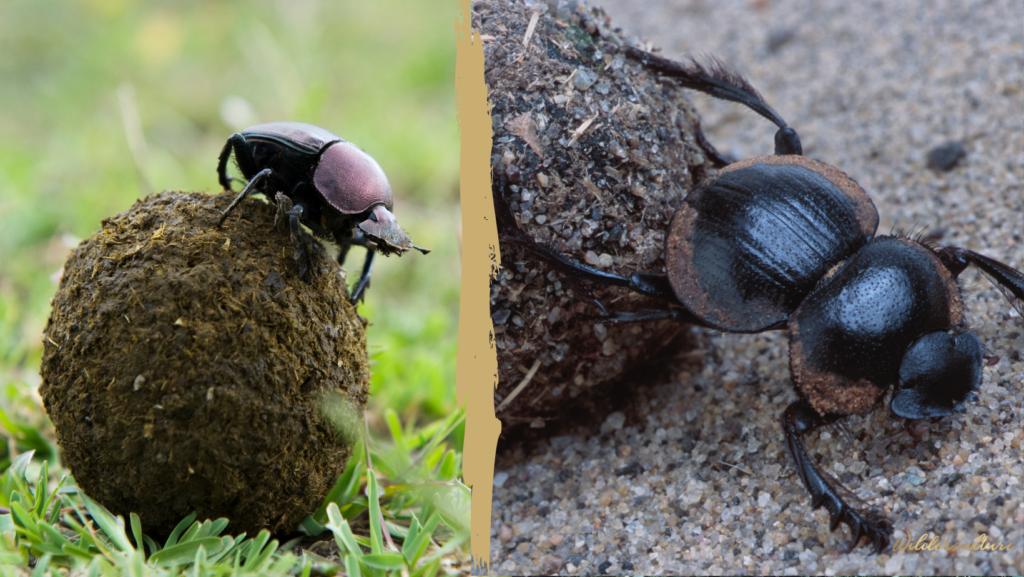
Iconic ‘roller’ dung beetles of warmer climes
We have all seen images on the TV of dung beetles in Africa rolling balls of dung backwards with their hind legs, but you might be surprised to know that in Britain we also have dung beetles, 60 species no less. What maybe won’t surprise you is that around 50% of those species are on the nationally scarce list.
Dung beetles fall into four ecological groups: Dwellers (Endocoprids), Tunnellers (Paracoprids), Stealers (Kleptocoprids) and Rollers (Telecoprids).
Rollers are found in warmer climates where competition for dung is higher, so the ability to roll it away to a burrow is a great advantage. Stealers steal the dung and the burrows of rollers, even killing their larvae. But all this exciting action takes place elsewhere, here in Britain dung beetle activity is, shall we say, a little more sedate, but by no means less interesting.
Britain’s Dung Beetles

Aphodiines – Dwellers
Aphodiines – Dwellers
This is the biggest group of dung beetles in the UK, comprising 44 species. These wee beasties spend their entire life cycle inside the dung pat. If you take a dung pile apart you will find their larvae within the pile. The beetles measure between 3-13 mm in length.
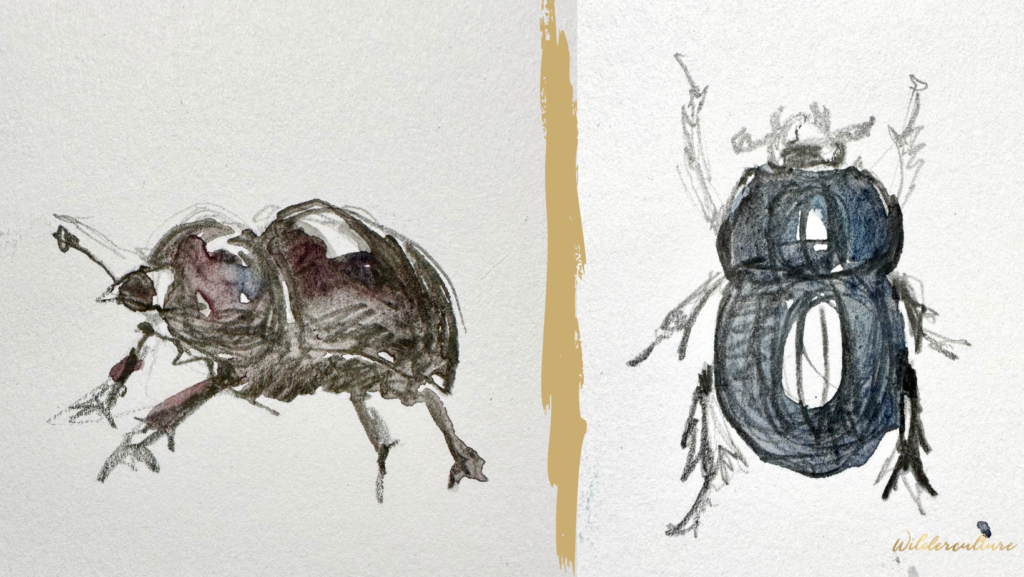
Geotrupes – Tunnellers
Geotrupes – Tunnellers
This is one of two groups of tunnelling dung beetles found in Britain, comprising 8 different species. They are the largest of our dung beetles. Geotrupes dig tunnels beneath the dung pile, dragging the dung down into the soil. Evidence of such activities can be found in the form of little piles of soil next to the dung pat. These beetles measure between 8-26 mm in length
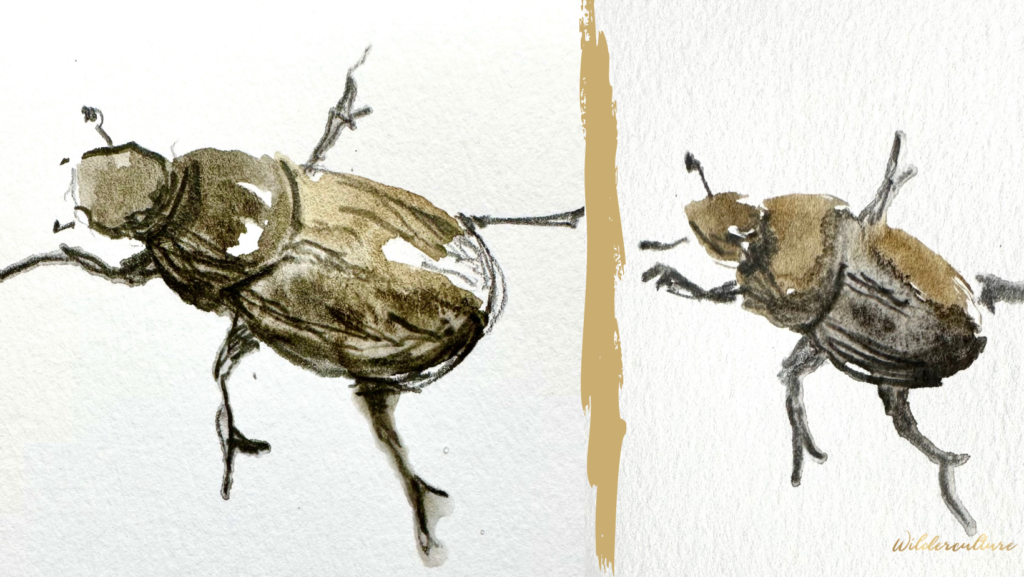
Onthophagus – Tunnellers
Onthophagus – Tunnellers
These species create tunnels below the dung pile just like Geotrupes, pulling balls of dung down into what will become incubation chambers for their larvae. These tunnels can be as deep as a metre. This group of dung beetles are part of the scarab beetle family and there are 8 species in the UK. These guys measure between 4-11 mm in length.
Life in the Dung Pile
Within our 60 species of dung beetles we find a wide array of preferences. Some are specialist, attending the dung piles of one single species of herbivore, while others are generalist, being less fussy about who did the dung, and more particular about things like its age; whether it is dry or wet; positioned in the sun or shade. Some dung beetles are active at night, others in the day.
Aphodiines species in dung at Wilder Gowbarrow
However, dung is by no means the exclusive territory of the dung beetles, far from it. Dung is the breeding ground of many species of fly and is essential to the life cycle of intestinal parasites, so it is in everyone’s interest to see the dung disappear into the soil as fast as possible!
Alongside dung beetles, there are many other beneficial species to be found. Phoretic mites for example – tiny, symbiotic mites that live on the bodies of dung beetles hitching a ride between pats, serving the greater good by eating fly larvae, which leaves more dung for the beetles.
The Hydrophilidae beetle is a beautiful shiny-black beast, often mistaken for a dung beetles. The adult feeds on dung, while the larvae predate on fly eggs, other larvae and insects. Then there are other types of beetles, worms, earwigs, parasitic wasps, spiders, yellow dung flies, woodlice, centipedes, millipedes, springtails, slugs and nematodes.
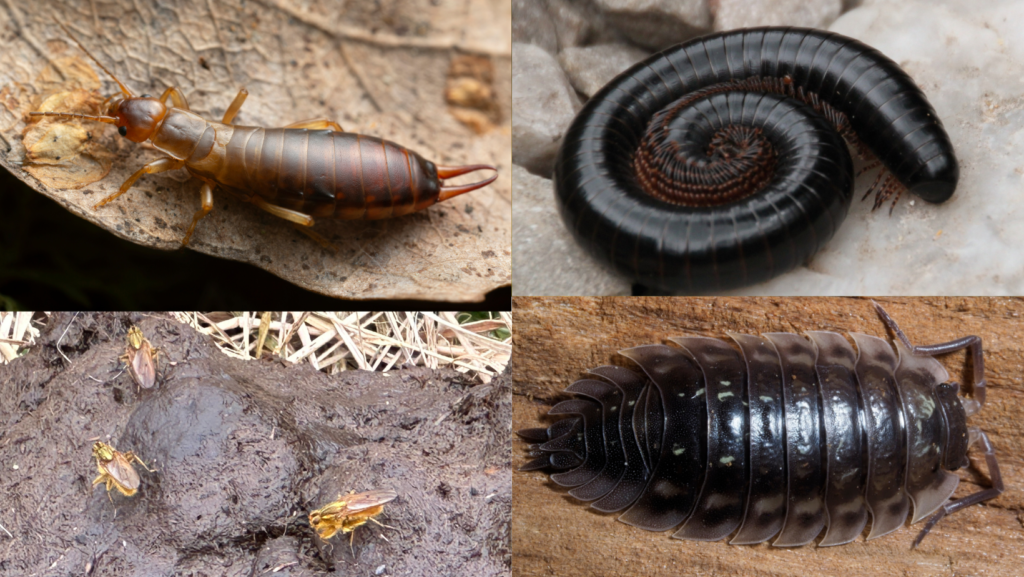
Earwing, millipede, woodlouse and yellow dung flies.
All in all dung is a veritable hive of activity, or at least it should be…
Dead Dung Pats
I wander around the fields of my Spanish home overturning dung pats left by the cows back in November and December in the hope of finding some activity, but I find none. The pats are now hard and dry, and doing little more than blocking out the light where grass and herbs are trying to grow. Others pats are a bit more weathered by the rain, the evidence of grass and acorns eaten months ago, easily identifiable.
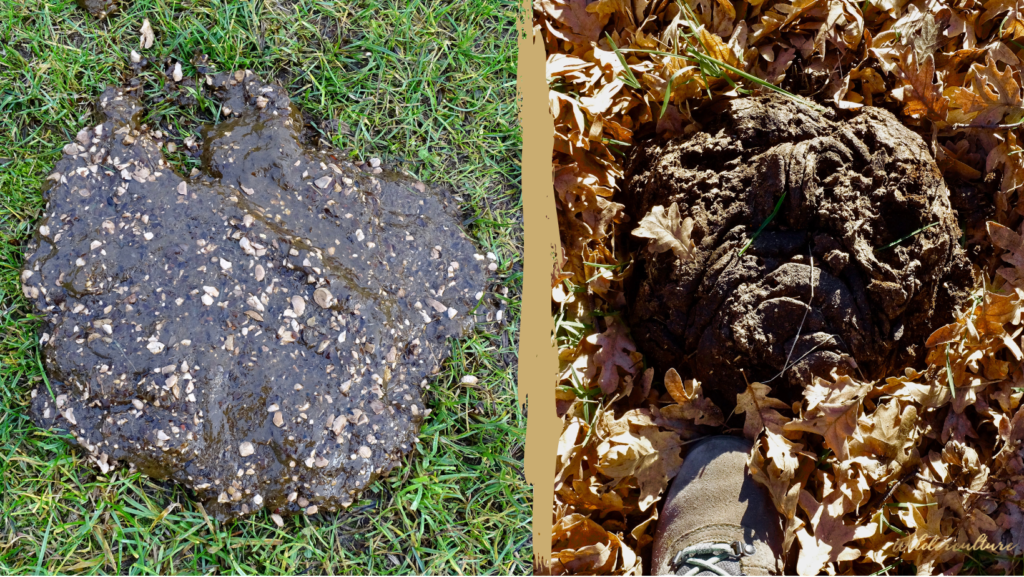
Dead dung pats new and old
There is only one conclusion to be drawn from this. The cattle that were here, receive regular worming and intestinal parasite treatments, so this dung is toxic to life.
Why Dung Beetles are so Vitally Important
There’s still a lot we don’t know about dung beetles, however what we do know is that they play a vital role in the health of the environment and the health and well-being of the herbivores that live and dung there.
Intestinal Parasites are one of the biggest threats to Animal Health
Dung is part of the intestinal parasite life cycle. Liver fluke eggs, for example, pass from an animal in their dung and remain there until they hatch around 9-10 days later, at which point the tiny miracidium larvae depart in search of their mud snail host for their next stage of metamorphosis. Roundworms, which are nematodes, pass in dung as eggs. Once they hatch, they have two larval stages of development within the dung, only at the third stage, do they depart to the grass to be consumed by unsuspecting animals.
One of the things that dung beetles do is drink the liquid in the dung pat, drying it out faster. This hampers the development of parasite larvae, as does all the disturbance by the beetles. Then the burrowing beetles and worms, drag the dung down into the soil, taking any larvae out of the picture.
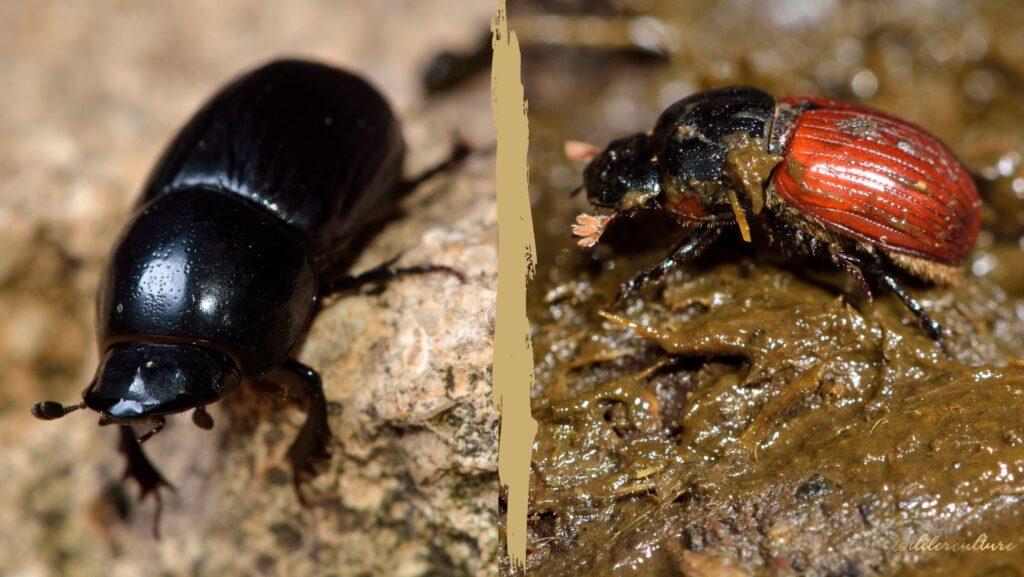
Aphodius fossorial (left) and Aphodius fimetarius (right). Two common species of dung beetle in Britain
If the conditions are right and the environment is free of chemical contaminants, this process will be sped up as the sheer number of organisms feeding on the dung, larvae and eggs. There is even a fungi Duddingtonia flagrans, which specialises in growing in dung pats in order to entrap and feed off nematodes such roundworm.
The extraordinary array of organisms that specialise in removing dung quickly and efficiently, not only protect livestock from reinfection but act to super-charge fertility as organic matter gets distributed within the soil. This is why herbivores are such an essential part of the landscape, their dung, a key element of whole-ecosystem function.
As intestinal parasites become more and more resistant to the increasingly toxic treatments available, regenerative grazing provides a light at the end of the tunnel. Brief grazing followed by long rest periods for each pasture, allows farmers to move away from prophylactic treatment, towards egg counts and treating only when necessary. This is good news seeing as intestinal parasites alone account for 17.94% of total farm losses, or around £36.44 per animal per year in the UK (1).
What Dung Beetles are up against…
Intestinal wormers will reduce the presence of life in a dung pile, because these treatments are effectively forms of insecticide. The result for bugs like dung beetles is either lethal or sub-lethal, where vitality and reproduction is inhibited.
The loss of permanent pasture to ploughing for rotational grassland and short-term leys, creates soil disturbance and reduced the availability of stable conditions in which dung beetles can reproduce. The addition of any fertilisers, herbicides, fungicides, etc, will also reduce the beetles ability to reproduce and thrive.
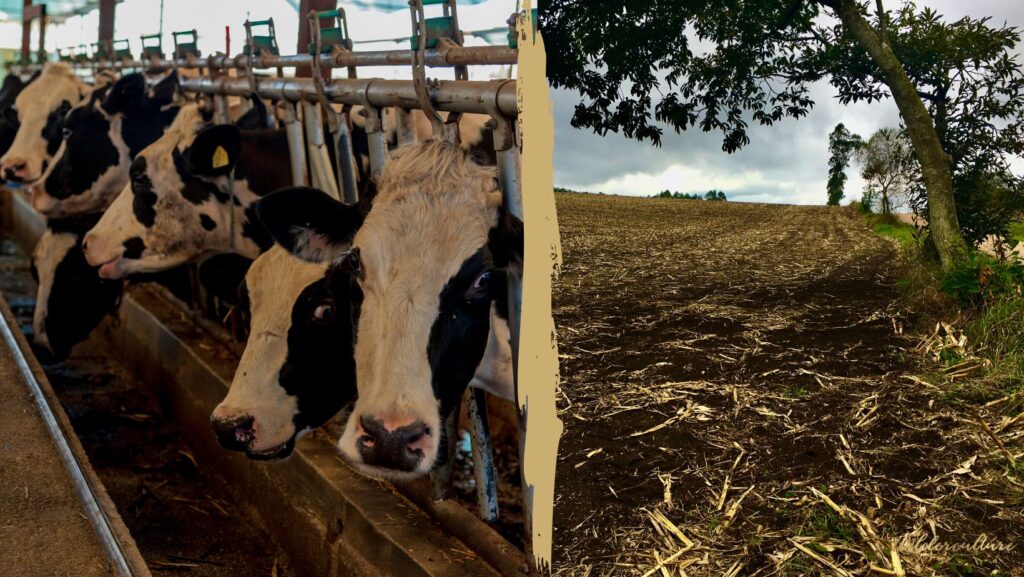
Mega-dairy’s in Galicia, Spain, where cows are fed whole maize silage.
Intensive livestock and dairy production means animals are housed year round or at the very least in the winter. This again reduces the availability of dung. The lack of animals outwintered is especially a problem for species active during winter and populations generally, when activity begins in spring. Early warm spells stimulate activity and the beetles need a home and food, especially if the weather turns cold again.
The Regenerative Good News
With the regenerative grazing techniques we teach at Wilderculture, the vast majority of animals are able to be outwintered on the land. This not only reduces the need for expensive bought-in feed, machinery and labour, but it means farmers are supporting dung beetles.
This in turn means that the diversity of beetles and all other insects increases. More variety means dung disappears into the soil much faster, helping solve problems of intestinal parasites and flies (who cause other problems like New Forest eye), who lay eggs in dung.
Adding species like chicory and willow into the mix will greatly reduce worm burdens as these species support the immune health of animals and act as natural wormers. Plants like sainfoin also contain tannins that disrupt parasite life cycles.
Finally, regenerative grazing systems are long grass systems which help control parasites because they tend to stay near the base of plants when waiting to be ingested.
At Wilderculture we work with farmers but also conservation/rewilding projects to enhance whole-ecosystem-function through planned grazing techniques. Healthy dung is key to restoring biodiversity as the dung creates so much more insect life and therefore food for birds, bats, invertebrates etc.
We Love Dung Beetles
I would like to acknowledge the excellent work of all the team @ Dung Beetles for Farmers, from whom this information has largely been gained. Please check out their fabulous website for more information!
References
(1) Gastrointestinal roundworms in cattle – consequences, cause, and controls
(2) Dung Beetles for Farmers
https://www.dungbeetlesforfarmers.co.uk
(3) Duddingtonia flagrans
(4) Duddingtonia flagrans: biocontrol fungus for reducing the use of anthelmintics
https://orgprints.org/id/eprint/44051/1/RELACS_PA_12_Duddingtonia_FiBL_final.pdf
1 Comment


Jackie Drake 1 year ago
Very interesting information thank you